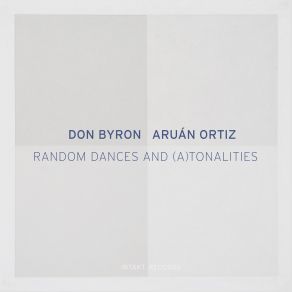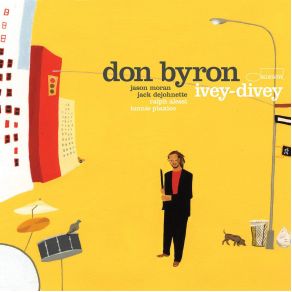Don Byron
Wikimp3 information about the music of Don Byron. On our website we have 19 albums and 25 collections of artist Don Byron. You can find useful information and download songs of this artist. We also know that Don Byron represents Jazz genres.
Biography
[Edit]An inspired eclectic, Byron has performed an array of musical styles with great success. Byron first attained a measure of notoriety for playing Klezmer, specifically the music of the late Mickey Katz. While the novelty of a black man playing Jewish music was enough to grab the attention of critics, it was Byron's jazz-related work that ultimately made him a major figure. Byron is an exceptional clarinetist from a technical perspective; he also possesses a profound imagination that best manifests itself in his multifarious compositions. At heart, Byron is a conceptualist. Each succeeding album seems based on a different stylistic approach, from the free jazz/classical leanings of his first album, Tuskegee Experiments (Nonesuch, 1992), to the hip-hop/funk of Nu Blaxpoitation (Blue Note, 1998). Byron's composition "There Goes the Neighborhood" was commissioned by the Kronos Quartet and premiered in London in 1994. He's also composed for silent film, served as the director of jazz for the Brooklyn Academy of Music, and scored for television. Byron was born and raised in New York City, the son of a mailman who also occasionally played bass in calypso bands, and a mother who dabbled on piano. As a child, Byron developed asthma; his doctor suggested he take up a wind instrument as therapy. Byron chose clarinet. His South Bronx neighborhood had a sizeable Jewish population, which partly explains his fascination with Klezmer. Byron was encouraged by his parents to learn about all different kinds of music, from Leonard Bernstein to Dizzy Gillespie. Byron's models on clarinet included Tony Scott, Artie Shaw, and especially Jimmy Hamilton. As an improviser, Joe Henderson was a prominent influence. As a teenager, Byron studied clarinet with Joe Allard. Byron attended the New England Conservatory of Music, where he studied with George Russell. While at NEC, Byron was recruited to play in Hankus Netsky's Klezmer Conservatory Band. Byron moved from Boston back to New York in the mid-'80s, where he began playing with several of the city's more prominent jazz avant-gardists, including David Murray, Craig Harris, and Hamiet Bluiett. A year after recording Tuskegee Experiments, Byron made Plays the Music of Mickey Katz(Nonesuch), which put something of an end to his Klezmer career (at least in terms of recording). Byron's career built steadily over the course of the '90s. By the end of the decade he had signed with Blue Note records. While hardly a radical, Byron is an original voice within the bounds of whatever style he happens to embrace.
Title: The Fo Tet Augmented
Artist: Don Byron, Ralph Peterson, Belden Bullock, Bryan Carrot
Genre: Jazz
Title: Random Dances & (A)Tonalities
Artist: Don Byron, Aruán Ortiz / Aruan Ortiz
Genre: Jazz, Contemporary Jazz
Title: Do the Boomerang: The Music of Junior Walker
Artist: Don Byron
Genre: Jazz, Contemporary Jazz
Collections
Title: The Harry Smith Project Live
Genre: Songwriter/Lyricist
Title: The Best of Festival of Light
Genre:
Title: Blue Note Remixed - 50 Of the Best
Genre: Jazz
Title: Sweet Soul Jazz Music
Genre: Hip Hop/R&B, Soul, Jazz
Title: Red Hot + Indigo
Genre: Jazz
Title: Modern Jazz Masters
Genre: Jazz
Title: Jazz For Miles
Genre: Jazz
Title: The Miles Davis Songbook
Genre: Jazz
Title: The Herbie Hancock Songbook
Genre: Jazz
Title: Jazz Plays Rock
Genre: Jazz
Title: The Ornette Coleman Songbook
Genre: Jazz
Title: The Joe Zawinul Songbook
Genre: Jazz
Title: Best of Jazz Clarinet
Genre: Jazz
Title: Jazz Groove
Genre: Jazz
Title: The Best Jazz Players of Today
Genre: Jazz
Title: Jazz: Rags and Drags
Genre: Jazz
Title: Klezmania: Klezmer for the New Millennium
Genre: World Music
Title: Compact Disc Club - Blue Note CD 4
Genre: Jazz
Title: Miles Davis: Tribute To A Genius
Genre: Jazz, Pop, Smooth Jazz
Title: Jazz Playlist - Soul
Title: Chill Out With Jazz
Genre: Jazz, Vocal Jazz, Smooth Jazz
Title: Jazz In Movies
Genre: Jazz, Vocal Jazz
Featuring albums
Title: 4 (ensemble) Compositions - 1992
Artist: Anthony Braxton
Genre: Jazz, Avant Garde Jazz, Avant Garde Metal
Title: DJ Smash Presents...Phonography-Volume 2
Artist: Various Artists
Genre: Dancefloor, Dance Pop
Title: Live At The Knitting Factory / Verna's Garage / The Living Room Tapes (CD1)
Artist: Allen Lowe
Genre: Jazz



































































